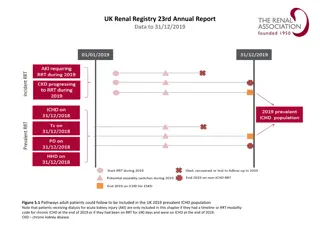
Information Theory in Digital Communication Systems
Explore the fundamentals of information theory in digital communication systems, covering topics such as self-information, source entropy, and the amount of information gained from specific events. Dive into the world of data transmission and learn how to quantify uncertainty in messages.
Download Presentation

Please find below an Image/Link to download the presentation.
The content on the website is provided AS IS for your information and personal use only. It may not be sold, licensed, or shared on other websites without obtaining consent from the author. If you encounter any issues during the download, it is possible that the publisher has removed the file from their server.
You are allowed to download the files provided on this website for personal or commercial use, subject to the condition that they are used lawfully. All files are the property of their respective owners.
The content on the website is provided AS IS for your information and personal use only. It may not be sold, licensed, or shared on other websites without obtaining consent from the author.
E N D
Presentation Transcript
1 4th. Year COMMUNICATION Main chapters II 3Hrs theor , 1 Hr pratical 1 Information theory 2Detection of digital signals in noise. 3- Source coding of discrete sources 4 Channelcoding. 5Introduction to digital signal processing (DSP) 6-Digital filter design 7-Selected digital communication systems INFORMATION THEORY Def: Information theory is a subject that deals with information and data transmission from one point to another. The block diagram of any digital communication system is shown below: Noise+jamming Source of information Listener receipter encoder channel decoder Audio Video Telex Computer : : modulation ciphering error correction data compression : : speaker TV computer typewriter : : The concept of information is related to probability. Any signal that conveys information must be unpredictable (random), but not visa versa, i.e. not any random signal conveys information.(noise is a random signal conveying no information). Self information: Suppose that the source of information produces finite set of messages x1, x2, x3, ., xn with prob. p(x1), p(x2), p(x3), ..,p(xn) and suchthat n p(xi ) = 1 . The amount of information gained by knowing thatthe i=1 source produces the message xi is related with p(xi) as follows: 1-information is zero if p(xi)=1 (certain event)
2 2-information increases as p(xi) decreases to zero. 3-information is a +ve quantity. The function that relates p(xi) with information of xi is denoted by I(xi) and is called self information of xi. The log function shown satisfies all previous three points hence: I (xi ) = loga p(xi) 1 if "a"=2 (this is mostly used in digital communication) then I(xi) has the units of bits. 2if "a"=e=2.71828, then I(xi) has the units of nats. 3- if "a"=10 , then I(xi) has the units of Hartly. Recall thatlogax =ln x lna Ex: A fair die is thrown, find the amount of information gained if you are told that 4 will appear. Solution: Since fair, die then, p(1)=p(2)= .=p(6)=1/6, then: I(4)=-log2 p(4)=-log2(1/6)=ln6/ln2=2.5849 bits. (note that if "a" is not given then a=2)
3 Ex: A biased coin has p(Head)=0.3. Find the amount of information gained if you are told that a tail will appear. Solution: P(tail)=1-p(Head)=1-0.3=0.7, then I(tail)=-log2(0.7)=-ln0.7/ln2=0.5145 bits. Ex: Find the amount of information contained in a black & white (B/W) TV picture if we assume that each picture has 2*105 dots (pixels or picture elements) and each pixel has 8 equiprobable and distinguishable levels of brightness. Solution: P(each level)=1/8 since equiprobable levels Information/pixel=-log2(1/8)=3 bits Information/picture=Information/pixel * no. of pixels =3 * 2* 105=600 kbits. pixel Homework: Repeat previous example for color TV with 16 equiprobable colors and 8 equiprobable levels of brightness. Source Entropy If the source produces not equiprobable messages then I(xi) , i=1,2, ..,n, are different. Then the statistical average of I(xi) over i will give the average amount of uncertainty associated with the source X. This average is the called source entropy and is denoted by H(X). This H(X) is given by: n H(X) = p(xi) I(xi) i=1 or
4 n H(X) = p(xi)log2p(xi) i=1 Ex: Find the entropy of the source producing the following messages: x1 x2 x3 x4 0.25 0.1 0.15 0.5 bits/symbol p(X) = 4 H(X) = p(xi)log2p(xi) Solution: i=1 H(X)=-[0.25ln0.25+ 0.1ln0.1+ 0.15ln0.15+0.5ln0.5]/ln2 H(X)=1.7427 bits/symbol Note: usually and according to our previous study in logic and digital electronic we are not familiar with fractions of bits. Here in communication, these fractions occur due to averaging., i.e., for the previous example the 1.7427 is the average, i.e, if the source produces say 100000 message, then the amount of information produced is 174270 bits. Ex: Find and plot the entropy of a binary source. Solution : p(0T)+p(1T)=1, hence: 0, p(0T) Binary source 1,p(1T) H(X)=-[ p(0T) log2p(0T)+ (1- p(0T)) log2(1- p(0T))] bits/symbol Note that H(X) is maximum equals 1 bit if p(0T)=p(1T)=0.5
5 Notes: 1-In general H(X)=H(X)|max=log2n bits/symbol if all messages are equiprobable, i.e, p(xi)=1/n, then : 1 1 H ( X ) =H ( X ) |max = [( log2 ( ) * n]=log n bits/symbol n n 2-H(X)=0 if one of the messages has the prob of a certain event. 2 SOURCE ENTROPY RATE This is the average rate of amount of information produced per second. It is denoted by R(X) and is given by: 1) R(X)= H(X) * rate of producing the symbols Where the units of R(X) is bits/sec (bps) if H(X) is in bits/symbol and the rate of producing symbols is symbols/sec. R(X) =H(X) Sometimes R(X) is also given as: 2) where : n = ip(xi)=average time duration of symbols, i is the time duration of i=1 the symbol xi. Ex:A source produces dots "." and dashes " " with p(dot)=0.65. If the time duration of a dot is 200ms and that for a dash is 800ms. Find the average source entropy rate.
6 Solution: P(dot)=0.65, then p(dash)=1-p(dot)=1-0.65=0.35. H(X)=-[0.65 log20.65 + 0.35 log20.35]=0.934 bits/symbol dot=0.2 sec, dash=0.8 sec, then = 0.2*0.65+ 0.8*0.35 = 0.41 sec R(X ) =H (X )=0.934= 2.278bps then 0.41 Ex: In a telex link, information is arranged in blocks of 8 characters. The 1st position(character) in each block is always kept the same for synchronization purposes . The remaining 7 places are filled randomly from the English alphabets with equal prob. If the system produces 400 blocks/sec, find the average source entropy rate. Solution: block Synch character Each of the 7 positions behaves as a source that may produce randomly one of the English alphabets with prob of 1/26, hence: Information/position= - log2(1/26)=log226=4.7 bits Information/block=7 * 4.7 =32.9 bits, we exclude the 1stcharacter since it has no information having the prob of certain event (contains synch only) Then: R(X)=Information/blocks * rate of producing blocks/sec =32.9 *400=13160 bits/sec
7 MUTUAL INFORMATION: The mutual information between two random variables measures the amount of information that one conveys about the other. Tx Noise Rx jamming X1 X2 X3 . . . Xn Y1 Y2 Y3 . . . Ym channel Consider the set of symbols x1, x2, ..,xn, the transmitter Tx may produce. The receiver Rx may receive y1,y2, ,ym. Theoretically, if the noise and jamming is zero, then the set X=setY and n=m. However, and due to noise and jamming, there will be a conditional prob p(yj/xi):Define: 1-p(xi) to be what is called the apriori prob of the symbol xi , which is the prob of selecting xi fortransmission. 2-p(xi/yj) to be what is called the aposteriori prob of the symbol xi after the reception of yj. The amount of information that yj provides about xi is called themutual information between xi and yj. This is givenby: p(xi /yj) p(xi) aposteroriprob =log apriori prob I(xi, yj) = log 2 2 Note that also and since p(xi) p(yj/xi)=p(yj) p(xi/yj)=p(xi,yj), then: p(yj/xi) p(yj) I(xi, yj) = log2 = I(yj,xi) i.e. the mutual information is symmetric. Note: p(xi/yj) p(yj/xi) in general. In fact, p(yj/xi) gives the prob of yj given that xi is transmitted, as if we are at the Tx and we transmit xi and we ask about the prob of receiving yj instead. The prob p(xi/yj) is the prob of xi given we receive yj as if we are at the Rx and we receive yj and we ask about if it was coming from xi.
8 Properties of I(xi,yj): 1 it is symmetric, i.e. I(xi,yj)=I(yj,xi) 2I(xi,yj)>0 if aposteriori prob> apriori prob, yj provides +ve information about xi. 3 I(xi,yj)=0, if aposteriori prob =apriori prob, which is the case of statistical independence when yj provides no information about xi. 4I(xi,yj)<0 if aposteriori prob< apriori prob, yj provides -ve information about xi, i.e., yj addsambiguity. Transformation(average mutual information): This is the statistical averaging of all the pair I(xi,yj), i=1,2, n, j=1,2,3 m. This is denoted by I(X,Y) and is given by: I(X,Y) = I(xi, yj)p(xi, yj) i=1 j=1 n m n m p(xi, yj) logp(xi / yj) I(X,Y) = bits/symbol 2 p(xi) i=1 j=1 or I(X,Y) = n m p(xi, yj)logp(yj/ xi) bits/symbol 2 p(yj) i=1 j=1 Marginal Entropies Tx: X channel Rx:Y Margins of the channel Marginal entropies are a term usually used to denote both source entropy H(X) defined as before and the receiver entropy H(Y) given by: m H(Y) = p(yj)log2p(yj) j=1 Joint and conditional entropies: The average amount of information associated with the pair (xi,yj) is called joint or system entropy H(X,Y): bits/symbol
9 m n H(X,Y) = H(XY) = p(xi, yj)log2p(xi, yj) j =1 i=1 The average amount of information associated with the pairs (yj/xi) & (xi/yj) are called conditional entropies H(Y/X) & H(X/Y), they are given by: m n H(Y / X) = p(xi, yj)log2p(yj/ xi) j=1 i=1 (average amount of uncertainty or information about y that remains if we are first told x) m n H(X /Y) = p(xi, yj)log2p(xi/ yj) j=1 i=1 (average amount of uncertainty or information that remains about x when y is known) Note : H(Y/X) H(X/Y) Ex: Show that H(X,Y)=H(X)+H(Y/X) bits/symbol 1) Noise entropy: bits/symbol 2) Losses entropy: bits/symbol Solution: This is a very useful identity to ease calculations in problem solving. To prove it, then we know that: H(X,Y) = p(xi, yj)log2p(xi, yj) j=1 i=1 But p(xi,yj)=p(xi) p(yj/xi), putting this inside the log term only, then: H(X,Y) = p(xi, yj)log2p(xi) p(xi, yj)log2p(yj/ xi) m n m n m n j=1 i=1 j=1 i=1 m After reversing the order of summation, then p(xi, yj) = p(xi) j=1 n n m Then:H(X,Y) = p(xi)log2p(xi) p(xi, yj)log2p(yj/ xi) i=1 In the above equation, the 1st term is in fact H(X) and the 2nd term with - sign is H(Y/X), then: H(X,Y)=H(X)+H(Y/X) i=1 j=1 Homework: Show that H(X,Y)=H(Y)+H(X/Y)
11 Ex: Show that I(X,Y)=H(X)-H(X/Y) n m p(xi, yj) logp(xi / yj) I(X,Y) = Solution: we know that: 2 p(xi) i=1 j=1 n m n m I(X,Y) = p(xi, yj)log2p(xi/ yj) p(xi, yj)log2p(xi) i=1 j=1 i=1 j=1 As before, we reverse the order of summation of the 2nd term, then p(xi, yj) = p(xi)and: j=1 I(X,Y) = p(xi, yj)log2p(xi/ yj) p(xi)log2p(xi) i=1 j=1 or I(X,Y)=H(X)-H(X/Y) m n m n i=1 Note: Above identity indicates that the transformation I(X,Y) is in fact the net average information obtained at the receiver coming from the difference between the original information produced by the source H(X) and that information lost at the channel H(X/Y)(losses entropy) due to noise and jamming. Homework: Show that I(X,Y)=H(Y)-H(Y/X) Ex: Show that I(X,Y) is zero for extremely noisy channel. Solution: For extremely noisy channel, then yj gives no information about xi ( the receiver can not decide anything about xi as if we transmit a deterministic signal xi but the receiver receives noiselike signal yj that is completely has no correlation with xi). Then xi and yj are statistically independent and p(xi/yj)=p(xi) and p(yj/xi)=p(yj) for all i and j , then: I(xi,yj)=log21=0 for all i & j , then I(X,Y)=0 y1 y2 x1 0.5 0.25 0.125 , Ex: The joint prob of a system is given by:p(X,Y) = x2 0 x3 0.0625 0.0625 find:
11 1-marginal entropies. 2-joint entropy. 3-conditional entropies. 4-the mutual information between x1 and y2. 5-the transinformation. 6-then draw the channel model. Solution: 1-First we find p(X) & p(Y) from p(X,Y) by summing the rows and columns: p( X ) = x1 H(X)=-[0.75 ln0.75 ) +2*0.125 ln0.125]/ln2=1.06127 bits/symbol H(Y)=-[0.5625 ln0.5625 + 0.4375 ln0.4375]/ln2=0.9887 bits/symbol 2-H(X,Y) = p(xi, yj)log2p(xi, yj) j=1 i=1 H(X,Y)=-[0.5log20.5 +0.25log20.25 +0.125log20.125+2*0.0625log20.0625] H(X,Y)=1.875 bits/symbol 3-H(Y/X)=H(X,Y)-H(X)=1.875-1.06127=0.813 bits/symbol H(X/Y)=H(X,Y)-H(Y)=1.875-0.9887=0.886 bits/symbol p(x1/ y2) I(x1,y2) = log but x3 y2 x2 y1 p(Y ) = 0.5625 0.4375 ,then: 0.75 0.125 0.125 m n p(x1/ y2) =p(x1,y2) 4- then: 2 p(y2) p(x1) p(x1,y2) 0.25 I(x1,y2) = log =log = 0.3923 bits 2 2 0.75*0.4375 p(x1)p(y2) That means y2 gives ambiguity aboutx1 5-I(X,Y)=H(X)-H(X/Y)=1.06127-0.8863=0.17497 bits/symbol 6- To draw the channel model, we find p(Y/X) matrix from p(X,Y) matrix by dividing its rows by the corresponding p(xi): y2 0.25/0.75 x1 x2 0/0.125 y1 y1 y2 1/3 x1 2/3 0.5/0.75 = p(Y / X) = note that the sum 0.125/0.125 x2 0 1 0.5 x3 0.0625/0.125 0.0625/0.125 of each row in p(Y/X) matrix is unity. x3 0.5
12 2/3 X1 Y1 1 X2 Y2 X3 0.5 Homework: For the channel model shown, Find:1-source entropy rate if x1=1ms and x2=2ms, I(x1)=2bits. 2-the transinformation. 0.9 X1 Y1 Y2 X2 Y3 0.8 Ex: Find and plot the transformation for a binary symmetric channel (BSC) shown if p(0T)=p(1T)=0.5 1-pe 0T 0R 1T 1R 1-pe Solution: This BSC is a very well known channel with practical values of pe<<1. If we denote 0T=x1, 1T=x2, 0R=y1, 1R=y2, then: y2 pe y2 0.5pe y1 y1 p(X,Y) = x1 0.5(1 pe) x2 0.5pe p(Y / X ) = x1 1 pe x2 pe 1 pe 0.5(1 pe) y2 0.5 and H(Y)=H(Y)|max=1 bit. Next, wefind p(Y ) = y1 0.5 Then H(Y/X), as: H(Y / X) = [{0.5(1 pe)log2(1 pe)}*2 +{0.5pelog2pe}*2] H(Y / X) = [(1 pe)log2(1 pe) + pelog2pe]
13 Then I(X,Y)=H(Y)-H(Y/X)=1+(1-pe) log2(1-pe)+pelog2pe 0.2 Homework:A BSC has p(Y / X ) = 0.8 , if I(0 )=3bits, findsystem 0.2 0.8 T and losses entropies. Ternary symmetric channel TSC: This has the transitional prob: y2 pe y3 pe pe y1 x1 1 2 pe p(Y / X )= 1 2 pe pe x2 x3 pe pe 1 2 pe This TSC is symmetric but not very practical since practically x1 and x3 do not affected so much as x2. In fact the interference between x1 and x3 is much less than the interference between x1 & x2 or x2 & x3.
14 1-2pe Y1 X1 X2 pe 1-2pe pe Y2 X2 X3 pe pe Y3 X3 1-2pe Hence, the more practical but nonsymmetric channel has the trans prob: y2 pe y3 0 pe y1 x1 1 pe p(Y / X )= 1 2 pe pe x2 x3 pe 0 1 pe Where x1 interfere with x2 exactly the same as interference between x2 and x3, but x1 and x3 are notinterfered. 1-pe Y1 X1 pe X2 pe 1-2pe Y2 X2 X3 pe pe Y3 X3 1-pe Other special channels: 1-lossless channel: This has only one nonzero element in each column of the transitional matrix p(Y/X). As an example:
15 y1 y5 y2 1/4 0 0 y3 0 1/3 0 y4 0 2/3 0 0 0 x1 3/4 p(Y / X )= x2 0 This channel has H(X/Y)=0 and x3 0 1 I(X,Y)=H(X) with zero losses entropy. (Homework: draw the channel model of this channel). 2-Determinstic channel: This has only one nonzero element in each row of the transitional matrix p(Y/X). As an example: y1 y2 y3 x1 1 x2 1 0 0 x3 0 1 0 1 0 noise entropy. (Homework: draw the channel model of this channel). 0 0 p(Y / X )= This has H(Y/X)=0 and I(X,Y)=H(Y) with zero 0 1 x4 0 x5 0 3-Noiseless channel: This has only one nonzero element in each row and column of the transitional matrix p(Y/X), i.e. it is an identity matrix. As an example: y1 y2 y3 x1 1 x2 0 1 0 x3 0 0 1 I(X,Y)=H(X)=H(Y). (Homework: draw the channel model of this channel). 0 0 This has H(X/Y)=H(Y/X)=0,and p(Y / X )= Definitions: Source efficiency and redundancy: Source efficiency= =H(X)/H(X)|max=H(X)/log2n Source redundancy=1- =1-[H(X)/log2n] Above can also be given as percentage. Venn Diagram representations of entropies: X=Transmitter Tx Y=Receiver Rx
16 H(X)source entropy H(Y)receiver entropy H(X,Y)system entropy I(X,Y) transformation H(Y/X)noise entropy H(X/Y)losses entropy Channel capacity (Discrete channels):(Discrete channel is a channel whose input X is discrete) This is defined as the maximum of I(X,Y): C=channel capacity=max[I(X,Y)] bits/symbol. Physically it is the maximum amount of information each symbol can carry to the receiver. Sometimes this capacity is also expressed in bits/sec if related to the rate of producing symbols r: C = r * max[I(X,Y)] bits/sec, where r is the number of symbols produced per second. C is also expressed as: C=max[R(X,Y)], where: R(X,Y)=rate of information transmission : R(X,Y) =I(X,Y)where : R(X,Y)= r * I(X,Y) bits/sec or n = ip(xi)=average time duration of symbols, i is the time duration of i=1 the symbol xi. The maximization of I(X,Y) is done with respect to input prob p(X) or output prob p(Y) for a constant channel conditions, i.e. with p(Y/X) being a constant.
17 Channel capacity of discrete symmetric channels: Def: Symmetric channels: Previously we mention some symmetric channels. A more general definition of symmetric channel is that channel where: 1 n=m , equal number of symbols in X & Y, i.e. p(Y/X) is a square matrix. 2 Any row in p(Y/X) matrix comes from some permutation of other rows. Examples: 0.9 0.1 1-p(Y / X ) = 0.1 permutation of the 2ndrow. 0.9 2-p(Y / X ) = 0.05 st is a BSC where n=m=2 and the 1 row is the 0.9 0.05 0.05 0.9 0.05 is TSC where n=m=3 and each row is a 0.05 0.05 0.9 permutation of the others.(same numbers appear) 3-p(Y / X ) = 0.8 0.1 0.1 is a nonsymmetric since n m( not square) 0.1 0.1 0.8 although the 1st row is permutation of the 2ndrow. 0.1 0.1 0.7 0.1 0.1 permutation of some other row, although n=m=3. 0.8 0.2 4-p(Y / X ) = 0.1 nd is a nonsymmetric since the 2 row is nota 0.8 Channel capacity of such symmetric channel is easy to find using the following derivation: To find max[I(X,Y)], then: I(X,Y)=H(Y)-H(Y/X) I(X,Y) = H(Y)+ p(xi)p(yj/ xi)log2p(yj/ xi) j=1 i=1 If the channel is symmetric then the quantity p(yj/ xi)log2p(yj/ xi) m n m j=1
18 is a constant independent of the row number i, so if this comes out of the double summation, the remaining is p(xi) which is equal to unity, n i=1 hence: I(X,Y) = H(Y) + p(yj/ xi)log2p(yj/ xi)= H(Y)+K j=1 m m Where K= p(yj/ xi)log2p(yj/ xi). j=1 Hence: I(X,Y)=H(Y)+K for symmetric channels only Now to find max of I(X,Y)=max[H(Y)+K]=max[H(Y)]+K And since max[H(Y)]=log2m when Y has equiprobable symbols, then: C=log2m+K bits/symbol for symmetric channels only Channel efficiency and redundancy Channel efficiency: =I(X,Y)and the channel redundancy C R=1- =1 I(X,Y) C Notes: 1-I(X,Y) becomes maximum equals C only if the condition for maximization is satisfied, i.e. only if Y has equiprobable symbols. This condition yields that X has also equiprobable symbols since if the output of a symmetric channel is equiprobable, then its input X is also symmetric. 2-For symmetric channel only, and to ease calculations, we can use the formula I(X,Y)=H(Y)+K. Ex: For the BSC shown: 0.7 X1 Y1 X2 Y2 0.7
19 Find the channel capacity and efficiency if I(x1)=2bits Solution: First we write p(Y/X), as: p(Y / X ) = 0.7 0.3 and since symmetric, then C=log m+K, n=m=2 0.3 0.7 2 and K = 0.7 log2 0.7 + 0.3log2 0.3 =-0.88129, then: C=log2 2 + K=1-0.88129=0.1187bits/symbol. To find the channel efficiency, then we must find I(X,Y). First, we find p(x1) from I(x1)=-log2 p(x1)=2, giving p(x1)=2-2=0.25, then: p(X)=[0.25 0.75], multiplying with p(Y/X) get: p(X,Y) = 0.7*0.25 0.6], from which H(Y)=0.97095 bits/symbol. Then: I(X,Y)=H(Y)+K=0.97095-0.88129=0.0896 bits/symbol. Then: =I(X,Y)/C=0.0896/0.1187=75.6%. 0.075 0.3*0.25 = 0.175 , thensumming 0.3*0.75 0.7*0.75 0.225 0.525 the columns to give p(Y)=[0.4 Homework: repeat previous example for the channel having transition 0.2 0.1 0.2 0.1 0.7 0.7 0.2 prob: p(Y / X ) = 0.1 0.7 Channel capacity of nonsymmetric channels: Procedure: 1- First, we find I(X,Y) as a function of input prob: I(X,Y)=f (p(x ), p(x ), .p(x ). subject to the constraint: p(xi) = 1 n 1 2 n i=1 i.e. use this constraint to reduce the number of variables by 1. 2Partial differentiate I(X,Y) with respect to the (n-1) input prob., then equate these partial derivatives to zero. 3 Solve the (n-1) equations simultaneously then find p(x1),p(x2), ,p(xn) that gives maximum I(X,Y).(Note that the condition here is not necessarily equiprobable since the channel is not symmetric. 4put resulted values of input prob. in the function f given in step 1 above to find C=max[I(X,Y)].
21 Ex: Find the channel capacity for the channel having transitional 0.3 p(Y / X ) = 0.7 0.1 0.9 prob: Solution: Note that the channel is not symmetric since the 1st row is not a permutation of the 2nd row. Now let p(x1)=p , then p(x2)=1-p, hence instead of having two variables, we will have only one variable p: Next we find p(X,Y) by multiplying the rows of p(Y/X) by p(X): 0.7p 0.3p p(X,Y) = , then: p(Y)=[0.1+0.6p 0.9-0.6p] and: H(Y/X)=-[ 0.7p ln 0.7 + 0.3p ln0.3 + 0.1(1-p) ln0.1 + 0.9(1-p) ln0.9]/ln(2) H(Y / X)=d H(Y / X)= [0.7 ln0.7 + 0.3 ln0.3 0.1ln0.1 0.9 ln0.9]/ln(2) p dp 0.1(1 p) 0.9(1 p) d H(Y / X)= [ 0.285781]/ln(2) dp Also: H(Y)=-[(0.1+0.6p) ln(0.1+0.6p) + (0.9-0.6p) ln(0.9-0.6p)]/ln2 Then: dH(Y)= [0.6 ln(0.1+ 0.6p) + 0.6 0.6 ln(0.9 0.6p) 0.6]/ln2 dp dH(Y)= [0.6 ln0.1+ 0.6p]/ln2 dp dI(X,Y) Then: dp 0.6ln0.1+0.6p+0.285781=0 0.9 0.6p dH(Y) = dp dH(Y / X) dp = 0 0.9 0.6p Solving for p=0.47187=p(x1), putting into H(Y) equation to get H(Y)=0.96021 bits/symbol, and in H(Y/X) equation to get H(Y/X)=0.66354 bits/symbol. And finally, C=max[I(X,Y)]=0.96021-0.66354=0.29666 bits/symbol.
21 Notes: 1Previous example, shows that finding C for nonsymmetric channel is not so easy mathematically, specially if the number of symbols is greater, then we have to partial differentiate I(X,Y) to get a set of (n-1) nonlinear equations whose solution is not always easy. 2Sometimes, we are asked to find C when the channel is not symmetric, but there are some similarities between some symbols( not all). In such a case, we can safely assume such similar symbols equiprobable, and then proceed as before. This note helps to more reduce number of variables. For example, the very practical ternary channel mentioned before having the transition prob: y1 y2 y3 0.1 x2 0.1 0.8 0.1 0.1 0.9 channel, so that we safely assume p(x1)=p(x3)=p, so that p(x2)=1-2p, then proceed as in previous example to find I(X,Y) as a function of only one variable p. Also, take another example shown below, where the channel is not y1 x1 0.9 0 p(Y / X )= , we note that x acts very similar to x in the 1 3 x3 0 y3 y2 0.1 0.1 0 0.9 p(Y / X ) = x1 0.9 is not a square matrix, but symmetric since x2 0 x1 is similar to x2, then we can assume that p(x1)=p(x2)=0.5, then use it to find I(X,Y) representing C. In such a case, no need for differentiation but be careful not to mix this special example with the symmetric case and the use of the formula C=log2m+K is not correct and gives wrong answer. 0.9 X1 Y1 Y2 X2 0.9 Y3
22 Cascading of channels: If two channels are cascaded as shown, then, the overall transition matrix of the equivalent channel is the matrix multiplication of the transitional prob of the two cascaded channels. Y Z X Channel 1 p(Y/X) (nxm) Channel 2 p(Z/Y) (mxr) 1 1 1 m r n p(Z/X) = p(Y/X) . p(Z/Y) Ex: Find the transition matrix p(Z/X) for the cascaded channel shown: 0.7 0.8 Y1 Z1 X1 Y2 Z2 X2 Y3 0.7 Solution: z1 z2 y1 y3 0 0.7 y2 0.2 0 y1 0.7 0.3 0 0 and p(Z /Y) = p(Y / X ) = x1 0.8 y2 1 y3 1 x2 0.3 0 0.7 0.3 0.76 0.24 0.8 0.2 0 1 0 = p(Z / X ) = 0.7 0.3 0.91 0.09 1 0
23 Homework: For previous example, find p(Y) and p(Z) if p(X)=[ 0.7 0.3] Entropies of continuous signals: If x and y are continuous random variables, with probability density functions p(x) and p(y), then in analogy with discrete sources the differential entropies of X & Y are given by: in bits/sample of the random variable x H(Y) = p(y) log2p(y) dy in bits/sample of the random variable y H(X) = p(x) log2p(x) dx And other entropies are also differential entropies and are given by: H(X,Y) = p(x, y) log2p(x, y) dx dyin bits/sample H(Y / X) = p(x, y) log2p(y/ x) dx dyin bits/sample. H(X /Y) = p(x, y) log2p(x / y) dx dyin bits/sample. p(x / y) dxdy I(X,Y) = p(x, y)log in bits/sample. 2 p(x) Note that all above entropies are differential entropies and not an absolute measure of information since all prob are in fact prob. density functions. Channel capacity of continuous Gaussian channel: Def: A Gaussian channel is that channel affected by the Gaussian noise. Review of Gaussian signal: If the noise signal n(t) is Gaussian then its PDF(prob density function): n 2 p(n) = e where =mean of n(t) and 2 isthe 1 0.5 2
24 variance of n(t). If n(t) is a thermal noise then we can assume that =0, and the frequency spectrum of this noise is flat over wide range of frequencies as shown. Gn(f) /2 Two-sided spectrum f This has two sided power spectral density Gn(f)= /2 W/Hz and one-sided power spectral density Gn(f)= W/Hz Gn(f One-sided spectrum f BW From Gn(f), we can find the noise power as N= BW in watts.
25 Since the spectrum is flat, we call this noise white noise. This white noise affects the signal x(t) as additive term, i.e., the received signal y(t)=x(t)+n(t). A very popular name of Additive, White, Gaussian, Noise (AWGN) is used for such thermal noise. The figure below shows how this AWGN affects equiprobable bipolar A signal. Time domain PDF function p(x) +A 0.5 0.5 -A x x(t) -A +A -A y(t) y Entropy of Gaussian noise: Mathematically, we can prove that if x(t) is a random variable, then the entropy of x is maximum if x(t) has Gaussian PDF. To find this entropy, then (and assuming =0) 1 H(X) = p(x) ln[ e 2 H(X) = p(x) ln 2 2 0.5x 2]dx nats/sample 1 x2 p(x)dx 2 2 dx+ But: x2p(x)dx = mean squareof x = 2+ 2= 2 and p(x) dx =1 then H(X ) = ln 2 + 0.5 =ln 2 + ln e
26 2 e ) H(X ) = ln( H(X) = log2( 2 e ) bits/sample nats/sample 0r Channel capacity of Gaussian channels A Gaussian channel is a channel affected by Gaussian noise n(t). Then: C=max[H(Y) - H(Y/X)], =max[receiver entropy noise entropy] It should be noted that, maximization is already included when we take the case of Gaussian noise, then: C = log2( Using previous expression of H(X) for Gaussian signal for the signal y with variance 2 then for the noise n(t) with variance 2 (noise power): 2 1 y y 2 But 2 = S=signal power and n 2 = N=noise power, then: C =1log 2 2 bits/sample For an analogue signal sampled at the Nyquist rate, then the sampling frequency is fs= 2 B samples/sec, where B is the bandwidth of the signal, S + N* 2B bits/sec, or: 2 C=B log2(1+SNR) bps. This is a very important formula known as SHANNON EQUATION named after C.E.Shannon, it is sometimes called Shannon-Hartly equation. 2 e y ) log2( 2 e n) y n C = log = log 2 2 2 But y = x + n sum of power, 2 2 2 n n x S + N=1log (1 +S) 2 2 N N hence: C =1log 2 N Notes on Shannon eq: 1Care must be taken regarding the units, here B is in Hz., SNR=signal to noise power ratio is in absolute, then, C is in bits/sec. If SNR is given in dB, then: SNR(absolute)=100.1(SNR in dB). 2the ratio [C/B]=log2(1+SNR) gives what is called channel utilization ratio ( bps per Hz) that increases with SNR as shown.
27 3-The equation C=B log2(1+SNR) gives the maximum theoretical performance in terms of maximum bit rate that can be transmitted over a channel having a bandwidth B and SNR ratio. Ex: Find the channel capacity of a Gaussian channel if its bandwidth increases without a limit. Solution: B increases without a limit means B , then: lim C= lim B log2(1+SNR). Note that SNR itself is a function of B: B B N= B ( is the one-sided noise spectral density), then: lim C= lim B log2[1+ (S/ B)]. To find this limit, let x=S/( B), then: B B lim C= lim [S/( x)][log2(1+x)], as B and (S/ ) is a constant, then B x 0 x 0, lim C = lim S log2 (1 + x) =Slim1/(1 + x)= S = 1.44S ln2 ln2 x
28 (S/ =1) Note: The result of previous example indicates that the channel capacity C approaches a limit of 1.44S/ even if B is very large. This result is very important for bandwidth unlimited channels, but power limited channels such as satellite channels, where the bandwidth may be large but signal power is a very important parameter. Ex: Find the maximum theoretical information rate that can be transmitted over a telephone channel having 3.5 KHz bandwidth and 15dB SNR. Solution: C is the maximum theoretical information rate, using Shannon eq, then: C = B log2(1+ SNR), where, SNR=15dB, changing into absolute SNR=100.1*15=31., then: C =3500 log2(1+31)=17500bps. Ex: A source produces 16 equiprobable symbols at a rate of 500 symbols/sec, check the possibility of transmitting this rate over the telephone channel of previous example. Solution: First, we find the rate of information from the source, which is the source entropy rate R(X): R(X)= H(X)* rate of symbols. H(X)=H(X)|max=log216=4bits (equiprobable case)
29 Then: R(X)=4 * 500= 2000 bps. Now since R(X) < 17500, then yes it is possible to transmit source output over this channel. Ex: Find the minimum theoretical time it would take to transmit 2500 octal digits over the telephone channel of the previous example. Solution: From previous example then C=17500 bps. A minimum theoretical transmission time is obtained if the channel operates at the maximum rate which is C, then: Tmin= [amount of information to be transmitted]/C Amount of information = 2500 * log28 =7500 bits (note each octal digit has log28=3bits of information), then: Tmin= 7500/17500=0.428sec. Ex: Find the minimum theoretical SNR required to transmit a compressed video information at a rate of 27Mbps over a channel having 5MHz bandwidth. Solution: For the minimum theoretical SNR, then put C=source bit rate =27Mbps, then: C= B log2(1+SNR) 27* 106 = 5* 106log2(1+SNR),or 1+SNR =25.4 SNR=41.2 absolute or SNR=16.1 dB















